NCERT Solutions Class 12 Biology Chapter 4 Principles of Inheritance and Variation have been provided below and is also available in Pdf for free download. The NCERT solutions for Class 12 Biology have been prepared as per the latest syllabus, NCERT books and examination pattern suggested in Class 12 by CBSE, NCERT and KVS. Questions given in NCERT book for Class 12 Biology are an important part of exams for Class 12 Biology and if answered properly can help you to get higher marks. Refer to more Chapter-wise answers for NCERT Class 12 Biology and also download more latest study material for all subjects. Chapter 4 Principles of Inheritance and Variation is an important topic in Class 12, please refer to answers provided below to help you score better in exams
Chapter 4 Principles of Inheritance and Variation Class 12 Biology NCERT Solutions
Class 12 Biology students should refer to the following NCERT questions with answers for Chapter 4 Principles of Inheritance and Variation in Class 12. These NCERT Solutions with answers for Class 12 Biology will come in exams and help you to score good marks
Chapter 4 Principles of Inheritance and Variation NCERT Solutions Class 12 Biology
Question. Mention the advantages of selecting pea plant for experiment by Mendel.
Answer. Mendel selected garden pea as his experimental material because of the following reasons:
(i) It is an annual plant with a short life-cycle. So, several generations can be studied within a short period.
(ii) It has perfect bisexual flowers containing both male and female parts.
(iii) The flowers are predominantly self-pollinating. It is easy to get pure line for several generations.
(iv) It is easy to cross-pollinate them because pollens from one plant can be introduced to the stigma of another plant by removing the anthers.
(v) Pea plant produces a large number of seeds in one generation.
(vi) Pea plants could easily be raised, maintained and handled.
(vii) A number of easily detectable contrasting characters/traits were available.
Question. Differentiate between the following:
(a) Dominance and recessiveness
(b) Homozygous and heterozygous
(c) Monohybrid and dihybrid
Answer. (a) Differences between dominance and recessiveness
| Dominance | Recessive |
| The phenomenon where one allele expresses itself even in the presence of other allele. | The phenomenon where an allele expresses itself in the absence of its dominant allele but remains masked in its presence. |
| Dominant allele forms a complete functional enzyme due to which complete polypeptide is formed to express completely. | Recessive allele forms incomplete or defective,or non-functional polypeptide enzyme, due to which non-functional polypeptide is formed and fails to express completely. |
(b) Differences between homozygous and heterozygous
| Homozygous | Heterozygous |
| When both alleles of a gene are similar, then the individual is called homozygous. | When both alleles of a gene are dissimilar, then the individual is called heterozygous. |
| The genotype is expressed as TT or tt, i.e.,they contain either both dominant alleles or both recessive alleles. | The genotype is expressed as Tt, i.e., they contain one dominant allele and one recessive allele. |
| They are true breeding, leading to pure lines. | They are not true breeding. |
| The gametes produced by them are similar in genotype. | The gametes produced by them are of two types, one with dominant allele and other with recessive allele. |
(c) Differences between monohybrid and dihybrid
| Monohybrid | Dihybrid |
| It is the cross between two individuals considering a single contrasting trait or character at a time. |
It is the cross between two individuals taking two contrasting traits or characters at a time. |
| It helps to study the inheritance of a pair of allele. | It helps to study the inheritance of two pairs of allele. |
| The phenotypic ratio in F2 generation is 3 : 1. | The phenotypic ratio in F2 generation is 9 : 3 : 3 : 1. |
| The genotypic ratio in F2 generation is 1 : 2 : 1. | The genotypic ratio in F2 generation is 1 : 2 : 2 : 4 : 1 : 2 : 1 : 2 : 1. |
Question. A diploid organism is heterozygous for 4 loci, how many types of gametes can be produced?
Answer. Here, we apply the formula 2n where n = number of loci.
The organism is heterozygous for 4 loci,
n = 4
So, 2n = 24 = 2 × 2 ×2 × 2 = 16
∴ The organism will produce 16 types of gametes.
Question. Explain the law of dominance using a monohybrid cross.
Answer. Law of dominance states that when two different allelomorphic forms (genes) are present in an organism, only one expresses itself in F1 generation which is called dominant gene while the other which does not show its effect and remains masked is called recessive gene.When a cross is performed between two individuals taking a single contrasting character at a time, it is called a monohybrid cross.
The character ‘height’ in pea plant has two alleles ‘T’ and ‘t’. ‘T’ exhibits tallness whereas ‘t’ exhibits dwarfness. When a pure tall (TT) pea plant is crossed with a pure dwarf (tt) plant, in the F1 generation hybrid (heterozygous) ‘Tt’ is obtained, which is tall due to the presence of allele ‘T’.
This shows that tallness is dominant over dwarfness which remain unexpressed in generation.
Thus, this cross explains law of dominance.
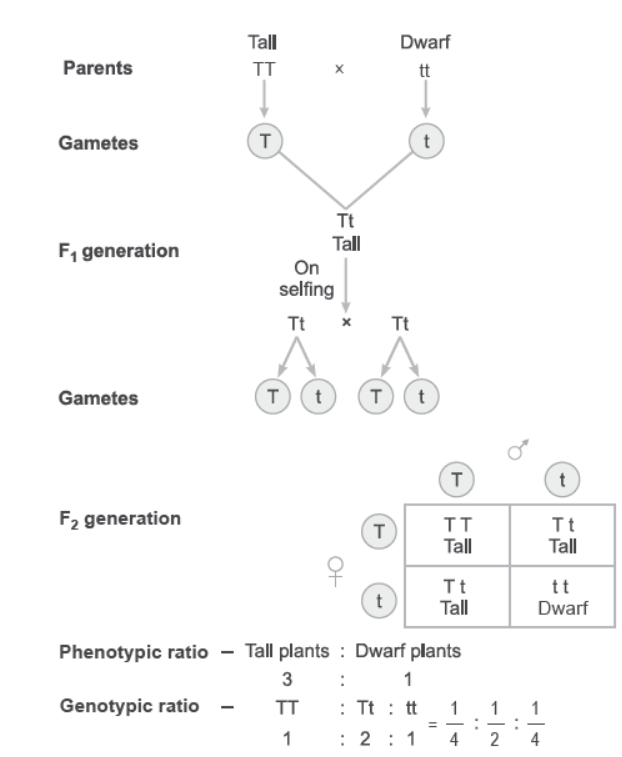
Question. Define and design a test cross.
Answer.- It is a method devised by Mendel to determine the genotype of an organism.
- In this cross, the organism with dominant phenotype (but unknown genotype) is crossed with the recessive individual.
- In a monohybrid cross between violet colour flower (W) and white colour flower (w), the F1 hybrid was violet colour flower. The test crosses are:

- If all the F1 progeny are violet coloured, then the plant is homozygous dominant, i.e., WW and if the
progenies are in 1 : 1 ratio, then the plant is heterozygous, i.e., Ww.
Question. Using a Punnett square, workout the distribution of phenotypic features in the first filial generation after a cross between a homozygous female and a heterozygous male for a single locus.
Answer. A cross between a homozygous female and heterozygous male follow two conditions:
Condition 1: Homozygous female: TT (Tall) Heterozygous male: Tt (Tall)
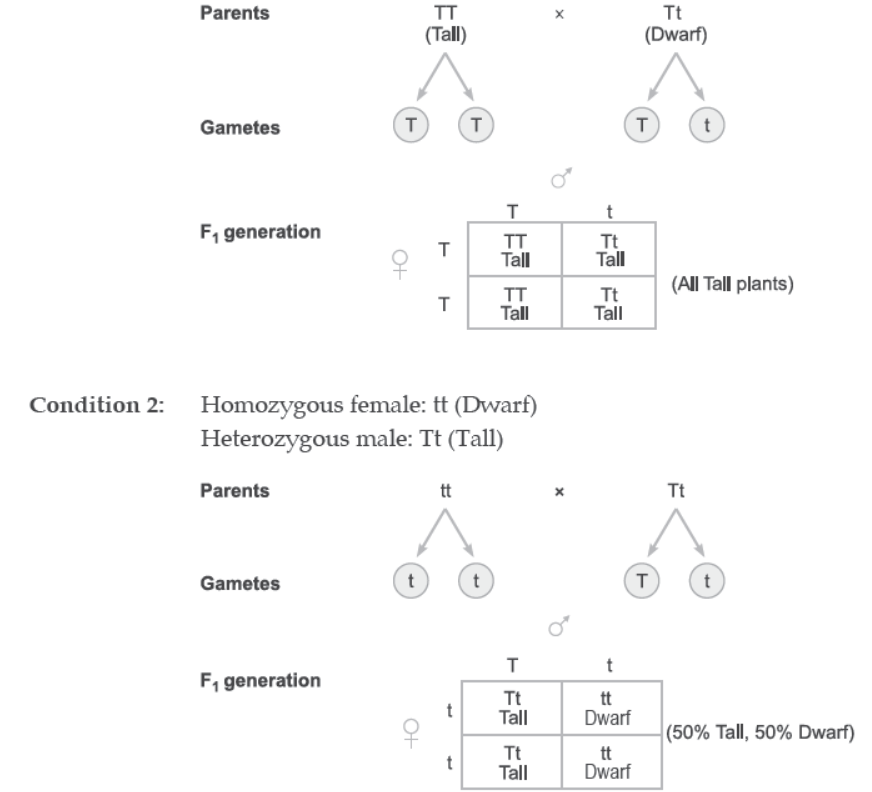
Question. When a cross is made between tall plant with yellow seed (TtYy) and tall plant with green seed (Ttyy), what proportions of phenotype in the offspring could be expected to be (a) tall and green (b) dwarf and green?
Answer.
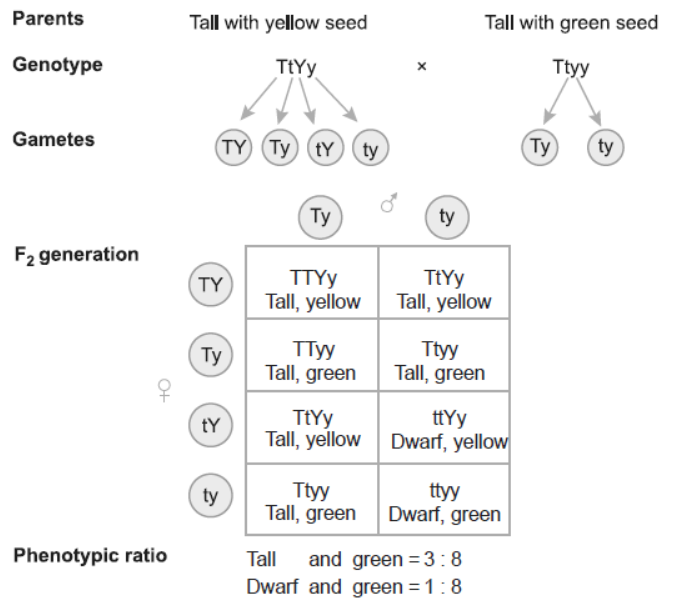
Question. Two heterozygous parents are crossed. If the two loci are linked what would be the distribution of phenotypic features in F1 generation for a dihybrid cross?
Answer. If the two loci are completely linked, then there would be no segregation and the F1 generation will exhibit parental characteristics only. But if the two loci are incompletely linked, then segregation would occur partly and the F1 generation will exhibit both parental and recombinant characteristics but the recombinants will be in a very small proportion depending on distance between gases.
Question. Briefly mention the contribution of T. H. Morgan in genetics.
Answer. T. H. Morgan (1866–1945) was given the Nobel Prize in 1933. His contributions are:
(i) Morgan worked on fruit fly Drosophila melanogaster and proposed the chromosomal theory of linkage.
(ii) He stated and established that genes are located on the chromosome.
(iii) He established the principle of linkage, crossing over, sex-linked inheritance and discovered the relationship between gene and chromosome.
(iv) He established the technique of chromosome mapping.
(v) He observed and worked on mutation.
Question. What is pedigree analysis? Suggest how such an analysis can be useful.
Answer. The study of inheritance of genetic traits in several generations of a human family in the form of a family tree diagram is called pedigree analysis.
- Advantages:
(i) It helps in genetic counselling to avoid disorders in future generations.
(ii) It shows the origin of a trait and flow of a trait in a family.
(iii) It is important to know the possibility of expressive recessive allele that can cause genetic disorders like colour blindness, haemophilia, etc.
(iv) Control crosses cannot be made in humans, so pedigree analysis helps us to study inheritance pattern of a trait.
(v) It helps us to understand whether the trait is dominant or recessive autosomal or sex-linked.
(vi) It predicts the harmful effects of marriage between close relatives.
(vii) It is extensively used in medical research.
Question. How is sex determined in human beings?
Answer. Human beings exhibit male heterogamy. In humans, males (XY) produce two different types of gametes, X and Y. The human female (XX) produces only one type of gametes containing X chromosomes. The sex of the baby is determined by the type of male gamete that fuses with the female gamete. If the fertilizing sperm contains X chromosome, then the baby produced will be a girl and if the fertilizing sperm contains Y chromosome, then the baby produced will be a boy. Hence, it is a matter of chance that determines the sex of a baby. There is an equal probability of the fertilizing sperm being an X or Y chromosome. Thus, it is the genetic make up of the sperm that determines the sex of the baby.
Question. A child has blood group O. If the father has blood group A and mother has blood group B, workout the genotypes of the parents and the possible genotypes of the offsprings.
Answer. The child will have blood group O only when the parents are heterozygous. Thus, the genotype of the parents would be IAi and IBi and that of the child will be i i. The cross of the parents is depicted below.
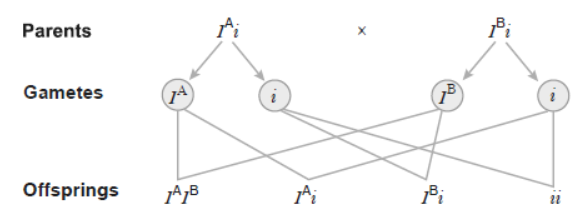
Thus the other possible genotype are IAIB (AB blood group) IAi, (A blood group), IBi (B blood group)
Question. Explain the following terms with example
(i) Co-dominance (ii) Incomplete dominance
Answer. (i) Co-dominance: When the F1 generation resembles both the parents, and both the parental characters are expressed simultaneously, then the phenomenon is called co-dominance.
For example, ‘AB’ type blood group is possible when allele ‘A’ and ‘B’ come together. Since both the alleles are expressing their effects in F1 generation, they are said to be co-dominant.
(ii) Incomplete dominance: In incomplete dominance, the genes of allelomorphic pairs are not expressed as dominant and recessive but instead express themselves partially when present together in the hybrid. As a result, F1 hybrids show characters intermediate of the parental genes. For example, Mirabilis jalapa (4 O’ clock plant) exhibits two types of flowers, red and white and the hybrids are pink coloured flowers.
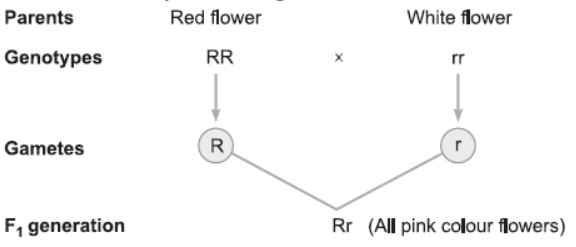
Question. What is point mutation? Give one example.
Answer. Point mutation is a gene mutation that arises due to change in a single base pair of DNA.
Example: Sickle-cell anaemia.

A substitution of a single nitrogen base (GAG → GUG) at the sixth codon of the β-globin chain of haemoglobin molecule causes substitution of Glutamic acid by Valine at 6th position & thus the change in the shape of the RBC from biconcave disc to elongated spindle shaped, structure which results in sickle-cell anaemia.
Question. Who had proposed the chromosomal theory of inheritance?
Answer. In 1902, Walter Sutton and Theodore Boveri proposed the chromosomal theory of inheritance.
Question. Mention any two autosomal genetic disorders with their symptoms.
Answer. Two autosomal genetic disorders are:
(a) Down’s Syndrome: It was first described by Langdon Down (1866). It is caused due to the presence of an additional copy of the chromosome number 21, i.e., trisomy (2n + 1). Symptoms:
(i) Short stature with small round head
(ii) Partially open mouth
(iii) Protruding furrowed tongue
(iv) Short neck
(v) Retarded mental development
(b) Phenylketonuria: It is an inborn error of metabolism. The affected individual lack an enzyme called phenylalanine hydroxylase that converts the amino acid phenylalanine into tyrosine.
As a result, phenylalanine gets accumulated and converted into phenylpyruvic acid and other derivatives in brain, causing mental retardation. These are also excreted through urine due to their poor absorption by kidney.
NCERT Solutions for Class 12 Biology Chapter 5 Principles of Inheritance and Variation MCQs
Choose and write the correct option in the following questions.
Question. Person having genotype IA IB would show the blood group as AB. This is because of
(a) pleiotropy
(b) co-dominance
(c) segregation
(d) incomplete dominance
Answer. B
Question. Test cross involves
(a) crossing between two genotypes with dominant trait
(b) crossing between two genotypes with recessive trait
(c) crossing between two F1 hybrids
(d) crossing the F1 hybrid with a double recessive genotype.
Answer. D
Question. Conditions of a karyotype 2n + 1, 2n – 1 and 2n + 2, 2n – 2 are called
(a) aneuploidy
(b) polyploidy
(c) allopolyploidy
(d) monosomy
Answer. A
Question. If a colour blind woman marries a normal visioned man, their sons will be
(a) all colour blind
(b) all normal visioned
(c) one-half colour blind and one-half normal
(d) three-fourths colour blind and one-fourth normal
Answer. A
Question. In a certain taxon of insects some have 17 chromosomes and the others have 18 chromosomes.
The 17 and 18 chromosome bearing organisms are
(a) males and females, respectively
(b) females and males, respectively
(c) all males
(d) all females
Answer. A
Question. Inheritance of skin colour in humans is an example on
(a) point mutation
(b) polygenic inheritance
(c) codominance
(d) chromosomal aberration.
Answer. B
Question. All genes located on the same chromosome
(a) form different groups depending upon their relative distance
(b) form one linkage group
(c) will not from any linkage groups
(d) form interactive groups that affect the phenotype
Answer. B
Question. Which of the following represents a pair of contrasting characters?
(a) Allele (or allelomorphs)
(b) Phenotype
(c) Homozygous
(d) Heterozygous
Answer. A
Question. A cross between two tall plants resulted in offspring having few dwarf plants. What would be the genotypes of both the parents?
(a) TT and Tt
(b) Tt and Tt
(c) TT and TT
(d) Tt and tt
Answer. B
Question. Distance between the genes and percentage of recombination shows
(a) a direct relationship
(b) an inverse relationship
(c) a parallel relationship
(d) no relationship
Answer. A
Question. Which one of the following is an example of polygenic inheritance?
(a) Skin colour in humans.
(b) Flower colour in Mirabilis jalapa.
(c) Production of male honey bee.
(d) Pod hsape in garden pea.
Answer. A
Question. If a genetic disease is transferred from a phenotypically normal but carrier female to only some of the male progeny, the disease is
(a) autosomal dominant
(b) autosomal recessive
(c) sex-linked dominant
(d) sex-linked recessive
Answer. D
Question. In the F2 generation of a Mendelian dihybrid cross the number of phenotypes and genotypes are
(a) phenotypes - 4; genotypes - 16
(b) phenotypes - 9; genotypes - 4
(c) phenotypes - 4; genotypes - 8
(d) phenotypes - 4; genotypes - 9
Answer. D
Question. If a plant heterozygous for tallness is selfed, the F2 generation has both tall and dwarf plants. It proves the principle of
(a) dominance
(b) segregation
(c) independent assortment
(d) incomplete dominance
Answer. B
Question. Two genes ‘A’ and ‘B’ are linked. In a dihybrid cross involving these two genes, the F1 heterozygote is crossed with homozygous recessive parental type (aa bb). What would be the ratio of offspring in the next generation?
(a) 1 : 1 : 1: 1
(b) 9 : 3 : 3 : 1
(c) 3 : 1
(d) 1 : 1
Answer. D
Question. In sickle cell anaemia glutamic acid is replaced by valine. Which one of the following triplets codes for valine? [NCERT Exemplar]
(a) G G G
(b) A A G
(c) G A A
(d) G U G
Answer. D
Question. Z Z/ZW type of sex determination is seen in
(a) platypus
(b) snails
(c) cockroach
(d) peacock
Answer. D
Question. In a dihybrid cross, if you get 9:3:3:1 ratio it denotes that
(a) the alleles of two genes are interacting with each other
(b) it is a multigenic inheritance
(c) it is a case of multiple allelism
(d) the alleles of two genes are segregating independently.
Answer. D
Question. Mendel’s Law of independent assortment holds good for genes situated on the
(a) non-homologous chromosomes
(b) homologous chromosomes
(c) extra nuclear genetic element
(d) same chromosome
Answer. B
Question. In Mendel’s experiments with garden pea, round seed shape (RR) was dominant over wrinkled seeds (rr), yellow cotyledon (YY) was dominant over green cotyledon (yy). What are the expected phenotypes in the F2 generation of the cross RRYY × rryy?
(a) Round seeds with yellow cotyledons, and wrinkled seeds with yellow cotyledons.
(b) Only round seeds with green cotyledons.
(c) Only wrinkled seeds with yellow cotyledons.
(d) Only wrinkled seeds with green cotyledons.
Answer. A
Question. Occasionally, a single gene may express more than one effect. The phenomenon is called
(a) multiple allelism
(b) mosaicism
(c) pleiotropy
(d) polygeny
Answer. C
Question. The inheritance pattern of a gene over generations among humans is studied by the pedigree analysis. Character studied in the pedigree analysis is equivalent to
(a) quantitative trait
(b) Mendelian trait
(c) polygenic trait
(d) maternal trait
Answer. B
Question. Which of the following will not result in variations among siblings?
(a) Independent assortment of genes
(b) Crossing over
(c) Linkage
(d) Mutation
Answer. C
Question. What will never be father’s blood group if the mother has blood group B and child blood group O?
(a) A
(b) B
(c) AB
(d) O
Answer. C
Question. It is said that Mendel proposed that the factor controlling any character is discrete and independent. His proposition was based on the
(a) results of F3 generation of a cross.
(b) observations that the offspring of a cross made between the plants having two contrasting characters shows only one character without any blending.
(c) self pollination of F1 offsprings.
(d) cross pollination of F1 generation with recessive parent.
Answer. B
NCERT Solutions for Class 12 Biology Chapter 5 Principles of Inheritance and Variation Assertion-Reason Questions
In the following questions a statement of assertion followed by a statement of reason is given. Choose the correct answer out of the following choices.
(a) Assertion and reason both are correct statements and reason is correct explanation for assertion.
(b) Assertion and reason both are correct statements but reason is not correct explanation for assertion.
(c) Assertion is correct statement but reason is wrong statement.
(d) Assertion is wrong statement but reason is correct statement.
Question. Assertion : In a monohybrid cross, only dominant characters exhibit themselves in the F1 generation
Reason : Dominant trait is expressed only in the heterozygous condition.
Answer. C
Question. Assertion : ABO blood group system is a good example of pleiotropic genes.
Reason : In ABO blood group system, when IA and IB alleles are present together, both express themselves.
Answer. D
Question. Assertion : Haemophilia never occurs in women.
Reason : Gene for haemophilia is located on X chromosome.
Answer. C
Question. Assertion : The genetic complement of an organism is called genotype.
Reason : Genotype is the type of hereditary properties of an organism.
Answer. A
Question. Assertion : The maximum frequency of recombination that results from crossing over of linked genes is 50 percent.
Reason : If distance between linked genes is longer, they show higher frequency of crossing over.
Answer. B
Question. Assertion : Down’s syndrome is caused due to absence of either X or Y sex chromosome.
Reason : Such individuals show mental retardation and broad head with characteristic features.
Answer. D
Question. Assertion : The law of independent assortment can be studied through dihybrid cross.
Reason : Only those genes show independent assortment which are linked.
Answer. C
Question. Assertion : In birds, females are heterogametic and males are homogametic.
Reason : In birds, females have ZW sex chromosomes and males have ZZ sex chromosomes.
Answer. A
Question. Assertion : Mendel successfully conducted his hybridisation experiments.
Reason : Garden pea was an ideal experimental material.
Answer. B
Question. Assertion : Sickle-cell anaemia is an autosome-linked recessive disorder.
Reason : It appears only in human male which can be transferred to their grandson through carrier daughter.
Answer. C
NCERT Solutions for Class 12 Biology Chapter 5 Principles of Inheritance and Variation Case-based/Source-based Question
1. Study the figures given below and answer the questions that follow.

Question. In a dihybrid cross, when would the proportion of parental gene combinations be much higher than non-parental types, as experimentally shown by Morgan and his group?
Answer. When the genes are linked.
Question. If two genes are located far apart from each other on a chromosome, how the frequency of recombination will get affected?
Answer. Frequency of recombination will be higher.
Question. What are ‘true breeding lines’ that are used to study inheritance pattern of traits in plants?
Answer. True breeding lines are plants which have undergone continuous self-pollination for several generations. These are homozygous for traits.
2. Study the flowchart given below and answer the questions that follow.
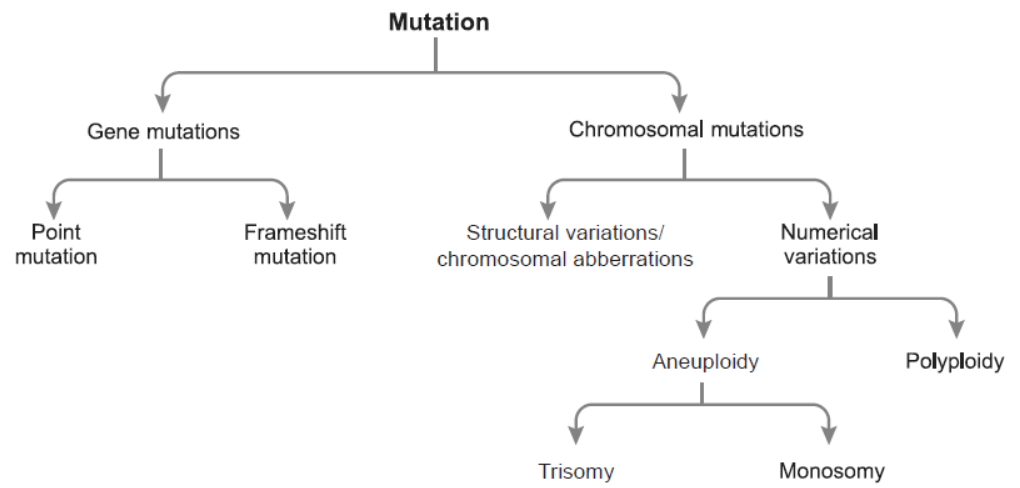
Question. What is a mutagen? Name a physical factor that can be mutagen.
Answer. All the physical and chemical factors that induce mutation are called mutagens. UV radiation and X-rays are physical mutagens.
Question. What is point mutation? Give one example.
Answer. Mutation arising due to change in a single base pair of DNA is called point mutation.
Question. Mention two causes of frame-shift mutation.
Answer. Insertion and deletion of three bases or multiples of three bases cause frame-shift mutation because the reading frame remains unaltered from that point onwards.
3. A relevant portion of β-chain of haemoglobin of a normal human is given below:

The codon for the sixth amino acid is GAG. The sixth codon GAG mutates to GAA as a result of mutation ‘A’ and into GUG as a result of mutation ‘B’. Haemoglobin structure did not change as a result of mutation ‘A’ whereas haemoglobin structure changed because of mutation ‘B’ leading to sickle shaped RBCs.
Question. Explain giving reasons how could mutation ‘B’ change the haemoglobin structure and not mutation ‘A’.
Answer. Due to mutation ‘A’, GAG mutates to GAA. But both GAG and GAA code for glutamic acid and hence there is no change in RBCs. Whereas GUG formed due to mutation ‘B’ codes for valine and so the RBCs become sickle-shaped.
Question. Write the genotype of (i) an individual who is carrier of sickle cell anaemia gene but apparently unaffected, and (ii) an individual affected with the disease.
Answer. (a) HbAHbS (b) HbSHbS
NCERT Solutions for Class 12 Biology Chapter 5 Principles of Inheritance and Variation Very Short Answer Questions
Question. Write the possible genotypes, Mendel got when he crossed F1 tall pea plants with a dwarf pea plant.
Answer. Possible genotypes: Tt and tt.
Question. Discuss is the genetic basis of wrinkled phenotype of pea seeds.
Answer. Wrinkled seed shape is a recessive trait. It expresses only under homozygous condition of alleles.
Question. How many kinds of phenotypes would you expect in F2 generation in a monohybrid cross?
Answer. Two (e.g., Tall and dwarf).
Question. A garden pea plant (A) produced inflated yellow pod, and another plant (B) of the same species produced constricted green pods. Identify the dominant traits.
Answer. Inflated green pod is the dominant trait.
Question. A garden pea plant produced round green seeds. Another of the same species produced wrinkled yellow seeds. Identify the dominant traits.
Answer. Round, yellow seed are the dominant traits.
Question. A human being suffering from Down’s syndrome shows trisomy of 21st chromosome. Mention the cause of this chromosomal abnormality.
Answer. Due to non-disjunction i.e., 21st pair of chromosomes fail to separate during gametogenesis.
Therefore, the gamete possesses 24 chromosomes instead of 23. When such a gamete fuses with another gamete, the zygote will have three copies of chromosome 21 causing trisomy.
Question. Why is it that the father never passes on the gene for haemophilia to his sons? Explain.
Answer. Haemophilia is a sex-linked recessive disease and the defective gene is present on X chromosome only and not on Y chromosome. Father never passes X chromosome to the son as father only contributes Y chromosome to the son.
Question. A geneticist interested in studying variations and patterns of inheritance in living beings prefers to choose organisms for experiments with shorter life cycle. Provide a reason.
Answer. This is because many generations can be obtained (in a short time) and selection of character
becomes faster.
Question. A haemophilic son was born to normal parents. Give the genotypes of the parents and son.
Answer. Father : 44 + XY
Mother : 44 + XXh
Son : 44 + XhY.
(Xh= X chromosome with gene for haemophilia)
Question. Mention any two contrasting traits with respect to seeds in pea plant that were studied by Mendel.
Answer. Round/Wrinkled, Yellow/Green
Question. When a tall pea plant was self-pollinated, one-fourth of the progeny were dwarf. Give the genotype of the parent and dwarf progenies.
Answer. Genotype of parent is Tt and the genotype of dwarf progenies is tt.
Question. Write the percentage of F2 homozygous and heterozygous populations in a typical monohybrid cross.
Answer. The ratio of a typical monohybrid cross is 1 : 2 : 1 where 50% are homozygous and 50% are heterozygous populations. (25% homozygous dominant, 25% homozygous recessive)
Question. Mention the type of allele that expresses itself only in homozygous state in an organism.
Answer. Recessive allele.
Question. Name one autosomal dominant and one autosomal recessive Mendelian disorder in humAnswer.
Answer. Huntington’s disease is an autosomal dominant disorder and sickle-cell anaemia is an autosomal recessive disorder.
Question. Mention the combination(s) of sex chromosomes in a male and a female bird.
Answer. Male bird – ZZ, Female bird – ZW
Question. Why do normal red blood cells become elongated sickle shaped structures in a person suffering from sickle cell anaemia?
Answer. Due to point mutation, glutamic acid (Glu) is replaced by valine (Val) at the sixth position of β-globin chain of haemoglobin molecule. Under oxygen stress erythrocytes lose their circular shape and become sickle-shaped.
Question. For the expression of traits, genes provide only the potentiality and the environment provides the opportunity. Comment on the veracity of the statement.
Answer. Phenotype = Genotype + Environment
(Trait) (Potentiality) (Opportunity)
Question. A cross was carried out between two pea plants showing the contrasting traits of height of the plant. The result of the cross showed 50% of parental characters. Name the type of cross.
Answer. Test cross
| NCERT Solutions Class 12 Biology Chapter 2 Sexual Reproduction in Flowering Plants |
| NCERT Solutions Class 12 Biology Chapter 3 Human Reproduction |
| NCERT Solutions Class 12 Biology Chapter 4 Reproductive Health |
| NCERT Solutions Class 12 Biology Chapter 5 Principles of Inheritance and Variation |
| NCERT Solutions Class 12 Biology Chapter 6 Molecular Basis of Inheritance |
| NCERT Solutions Class 12 Biology Chapter 7 Evolution |
| NCERT Solutions Class 12 Biology Chapter 8 Human Health and Disease |
| NCERT Solutions Class 12 Biology Chapter 10 Microbes in Human Welfare |
| NCERT Solutions Class 12 Biology Chapter 11 Biotechnology Principles And Processes |
| NCERT Solutions Class 12 Biology Chapter 12 Biotechnology and its Applications |
| NCERT Solutions Class 12 Biology Chapter 13 Organisms and Populations |
| NCERT Solutions Class 12 Biology Chapter 14 Ecosystem |
| NCERT Solutions Class 12 Biology Chapter 15 Biodiversity and Conservation |
NCERT Solutions Class 12 Biology Chapter 4 Principles of Inheritance and Variation
The above provided NCERT Solutions Class 12 Biology Chapter 4 Principles of Inheritance and Variation is available on our website for free download in Pdf. You can read the solutions to all questions given in your Class 12 Biology textbook online or you can easily download them in pdf. The answers to each question in Chapter 4 Principles of Inheritance and Variation of Biology Class 12 has been designed based on the latest syllabus released for the current year. We have also provided detailed explanations for all difficult topics in Chapter 4 Principles of Inheritance and Variation Class 12 chapter of Biology so that it can be easier for students to understand all answers. These solutions of Chapter 4 Principles of Inheritance and Variation NCERT Questions given in your textbook for Class 12 Biology have been designed to help students understand the difficult topics of Biology in an easy manner. These will also help to build a strong foundation in the Biology. There is a combination of theoretical and practical questions relating to all chapters in Biology to check the overall learning of the students of Class 12.
You can download the NCERT Solutions for Class 12 Biology Chapter 4 Principles of Inheritance and Variation for latest session from StudiesToday.com
Yes, the NCERT Solutions issued for Class 12 Biology Chapter 4 Principles of Inheritance and Variation have been made available here for latest academic session
Regular revision of NCERT Solutions given on studiestoday for Class 12 subject Biology Chapter 4 Principles of Inheritance and Variation can help you to score better marks in exams
Yes, studiestoday.com provides all latest NCERT Chapter 4 Principles of Inheritance and Variation Class 12 Biology solutions based on the latest books for the current academic session
Yes, NCERT solutions for Class 12 Chapter 4 Principles of Inheritance and Variation Biology are available in multiple languages, including English, Hindi
All questions given in the end of the chapter Chapter 4 Principles of Inheritance and Variation have been answered by our teachers

